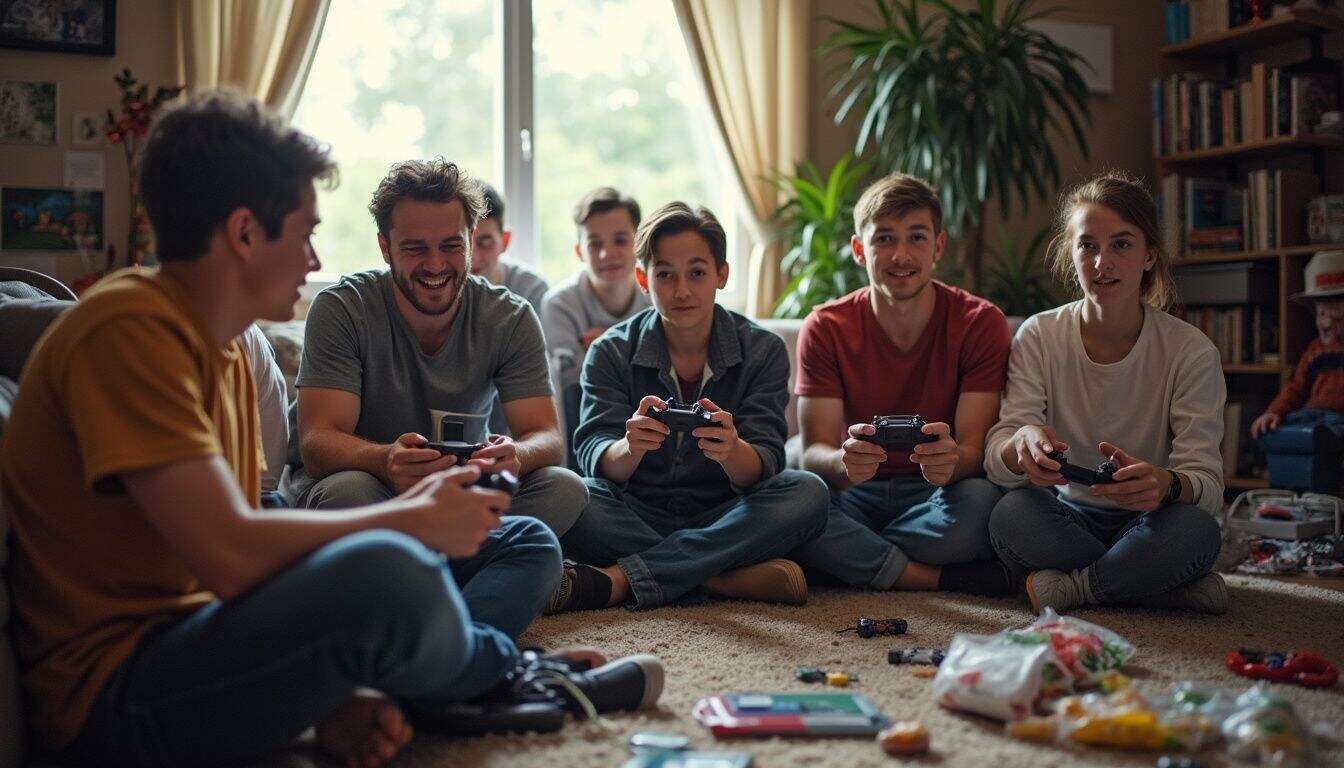Ever sunk a few hours into Candy Crush or teamed up with friends in Call of Duty and wondered, “Am I a gamer?”
It’s a funny question, right? For a long time, it felt like you needed a special membership card to join the “true gamer” club, leaving a lot of us who just enjoy playing video games feeling like we’re on the outside looking in.
You might be surprised to learn just how massive the gaming world is. The global gaming community is expected to have around 3.5 billion players in 2025. Yet, not everyone who plays is quick to claim the title.
This post is all about figuring out why people call themselves gamers. We’ll look at everything from the gaming industry and different player types to how Twitch streamers and esports pros are changing the game.
So, if you’ve ever wondered where you fit in, you’re in the right place. Let’s figure this out together.
Key Takeaways
The term “gamer” has shifted from 15th-century gamblers to anyone who plays digital games. While global gamers are projected to hit 3.5 billion in 2025, many still don’t identify with the label.
Women make up about 46% of players in the U.S., but stereotypes and gatekeeping often prevent them from identifying as gamers.
Gaming communities on platforms like Discord and Twitch create powerful social bonds. LGBTQ+ groups, known as gaymers, provide essential safe spaces, which is critical when many have faced online harassment.
The rise of casual gaming means anyone playing for quick fun, like with the top-grossing casual game of 2024, Monopoly Go!, can be a gamer, but negative stereotypes still cause hesitation.
Professional gamers can earn significant salaries in the booming esports industry, which is projected to generate $4.8 billion in revenue in 2025, further legitimizing gaming as a career.
Table of Contents
Understanding the Term “Gamer”

The word “gamer” means something different to everyone. It could be someone enjoying puzzle games on their phone or a streamer broadcasting hardcore titles from their couch. As the world of gaming grows, this label keeps changing right along with it.
What does the term “gamer” mean?
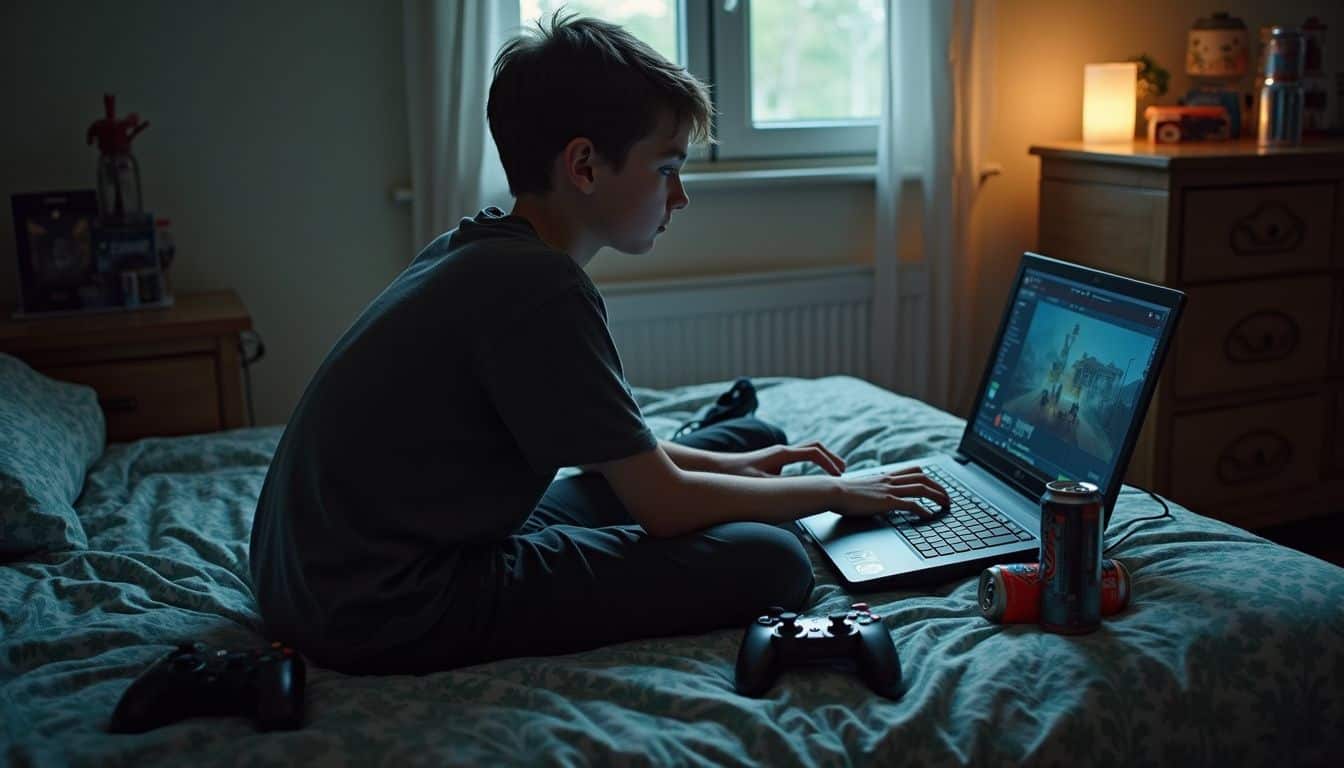
People use “gamer” to describe anyone who plays digital games, whether that’s puzzle games, fighting games, or massive online adventures (MMOs). Many gamers spend hours on consoles, computers, or smartphones.
Some are hardcore gamers chasing the next big win in esports, while others prefer casual games while waiting for their coffee to brew—including some who play casual online casino games, enjoying awesome bonuses and perks.
Interestingly, the term dates back to 1422 England, where it referred to people who gambled. Even today in some places, “gaming” can still mean betting as much as it means playing video games with friends.
For most, “gamer” signals belonging to a community that loves play and competition. The late Nintendo president Satoru Iwata famously tried to blur the lines between “core” and “casual” labels, believing that everyone who plays is a gamer.
This label is more than just a description of a hobby. Social identity theory suggests it’s a reflection of pride and connection. Whether you’re playing Tetris every day or speedrunning Doom, you fit under the gamer umbrella.
Some players grind for ranks every night, while others just want one good round before bed. Either way, they’re all part of the same world.
How has the meaning of “gamer” changed over time?
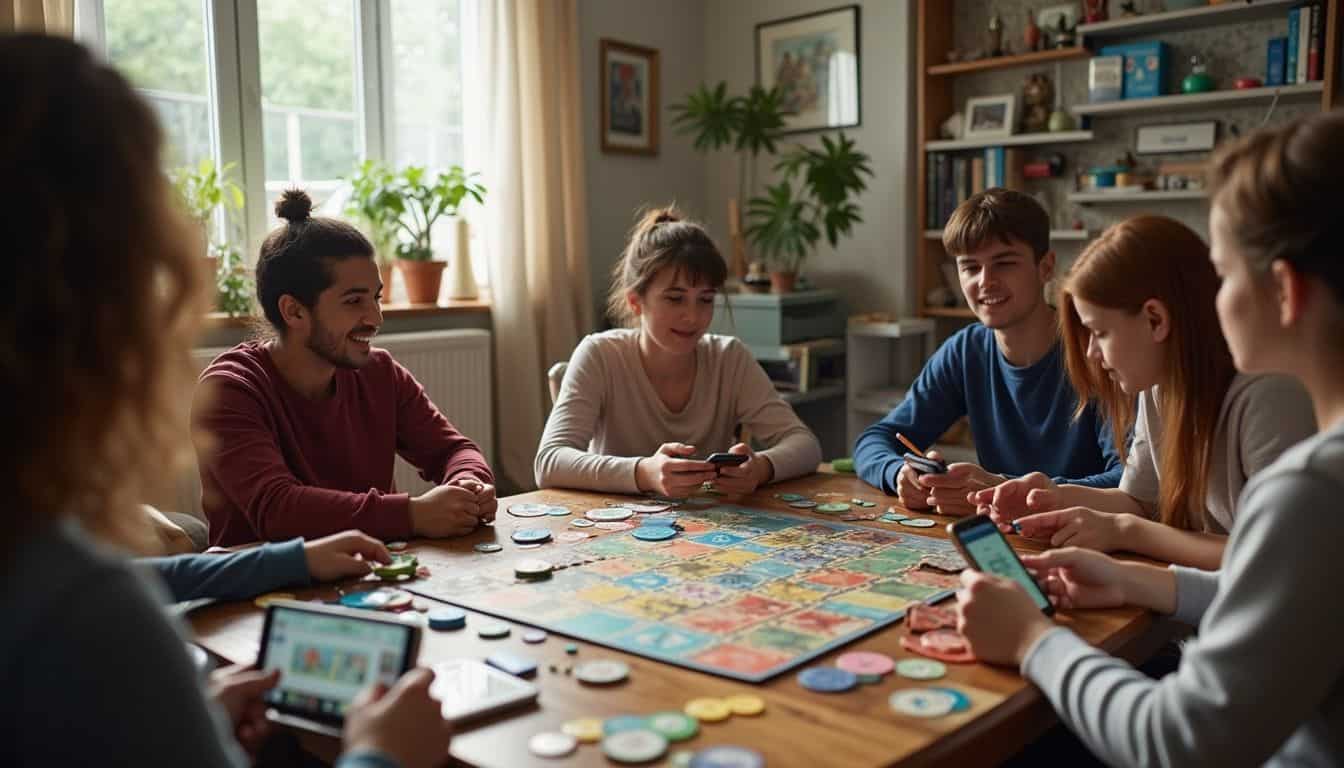
Back in the 1970s and ’80s, you’d mostly hear “gamer” used for hobbyists playing wargames or Dungeons & Dragons. The 1990s kept things pretty niche, with video gamers sticking to specific online forums and communities.
A big shift came in the late 1990s with the Bartle taxonomy, which sorted players into types like Achievers, Explorers, Socializers, and Killers. This framework gave everyone a new way to think about why they play.
Everything really changed in the last decade. The rise of smartphones made gaming accessible to billions. Now, a gamer can be anyone, from someone swiping through Candy Crush to an esports champion competing in a packed stadium. According to the ESA’s 2024 report, 78% of players in the U.S. now play on mobile devices.
Live streaming on platforms like Twitch and YouTube has also shattered old stereotypes. The label now comfortably fits casual gamers, LGBTQ+ gamers, and players from every corner of the globe, making the term more inclusive than ever.
Psychological Reasons People Identify as Gamers
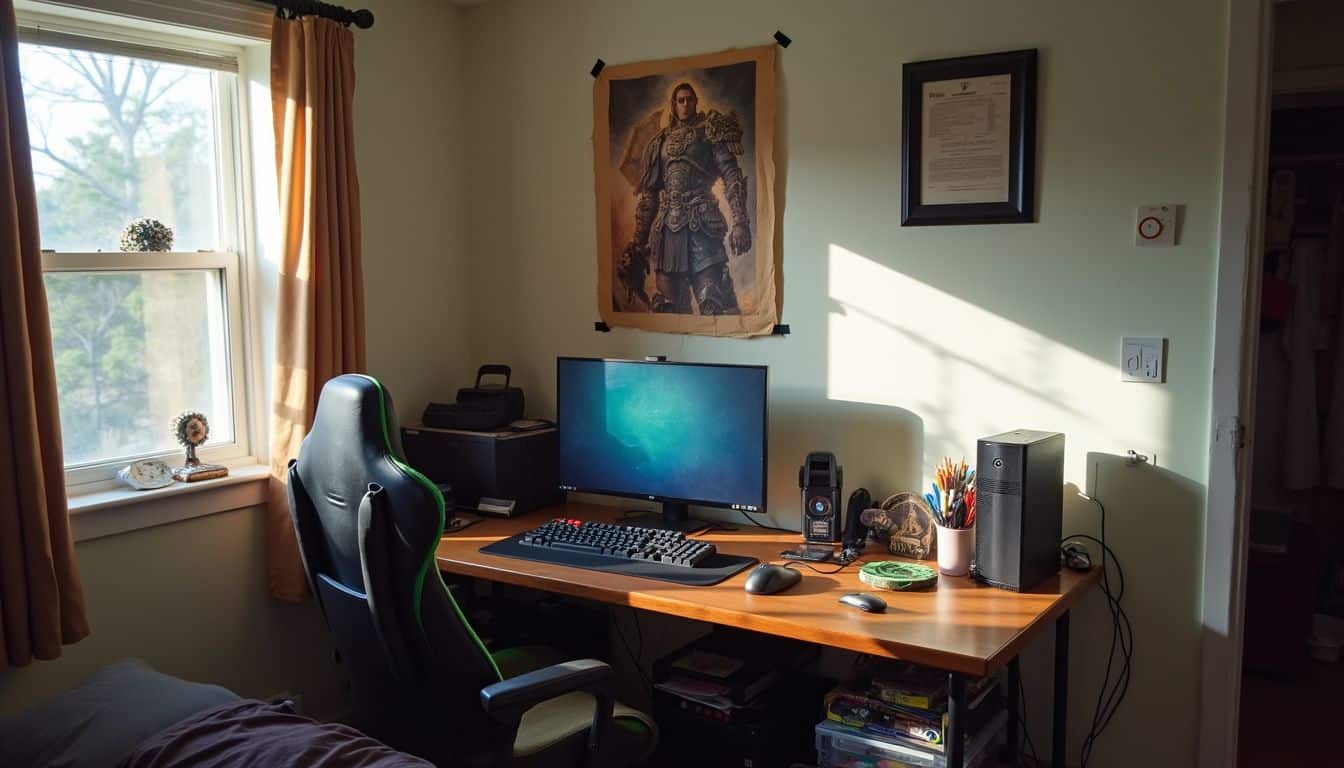
People often find genuine friendships through online multiplayer games. The avatars we choose and the games we love can say a lot about who we are in our daily lives.
How does gaming create a sense of community and belonging?

Social gaming is a powerful way to bring people together. Multiplayer games like Fortnite or even the cozy world of Animal Crossing create spaces where friendships spark and alliances form.
Clans and guilds in games act as digital clubhouses for people with shared goals. I still trade items with an online friend I met years ago in a game, and our bond feels just as real as any I’ve made offline.
These online communities can be a huge help for overcoming loneliness or shyness. They provide teams to join and safe places to chat. A 2024 Pew Research study found that nearly half of U.S. teens say video games have helped them make new friends.
LGBTQ+ groups find vital support through gaymer clubs and dedicated Discord servers. These digital circles offer a sense of belonging when real life might fall short, letting anyone grab a controller and feel right at home.
What psychological needs do gamers fulfill?
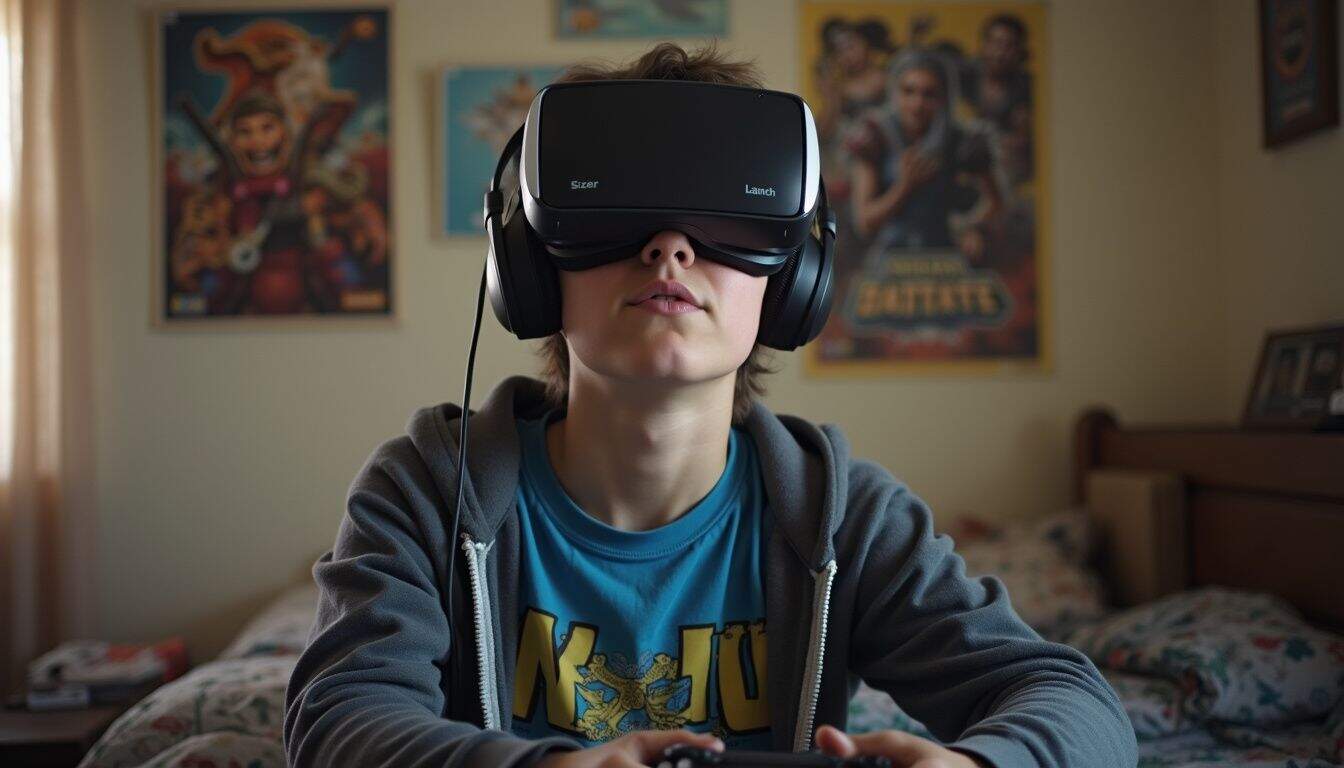
Mastery, control, and the thrill of a good challenge are huge draws for many players. This is perfectly explained by Self-Determination Theory (SDT), a framework that says we are all driven by three core needs: autonomy (control), competence (skill), and relatedness (social connection).
Games are brilliant at satisfying these needs.
- Autonomy: Open-world games like The Legend of Zelda: Tears of the Kingdom give you the freedom to explore and make your own choices.
- Competence: Overcoming a tough boss in a game like Elden Ring provides a powerful sense of accomplishment and skill growth.
- Relatedness: Joining a guild in World of Warcraft or a squad in Helldivers 2 forges strong social bonds and friendships.
This feeling of connection is a major reason people keep coming back. “I joined my first online clan at 13; suddenly I felt like part of something bigger than myself,” said Taylor, now a professional gamer.
Games gave me a place where failure wasn’t final, it was just another try.
Why do gamers seek escapism and immersion?
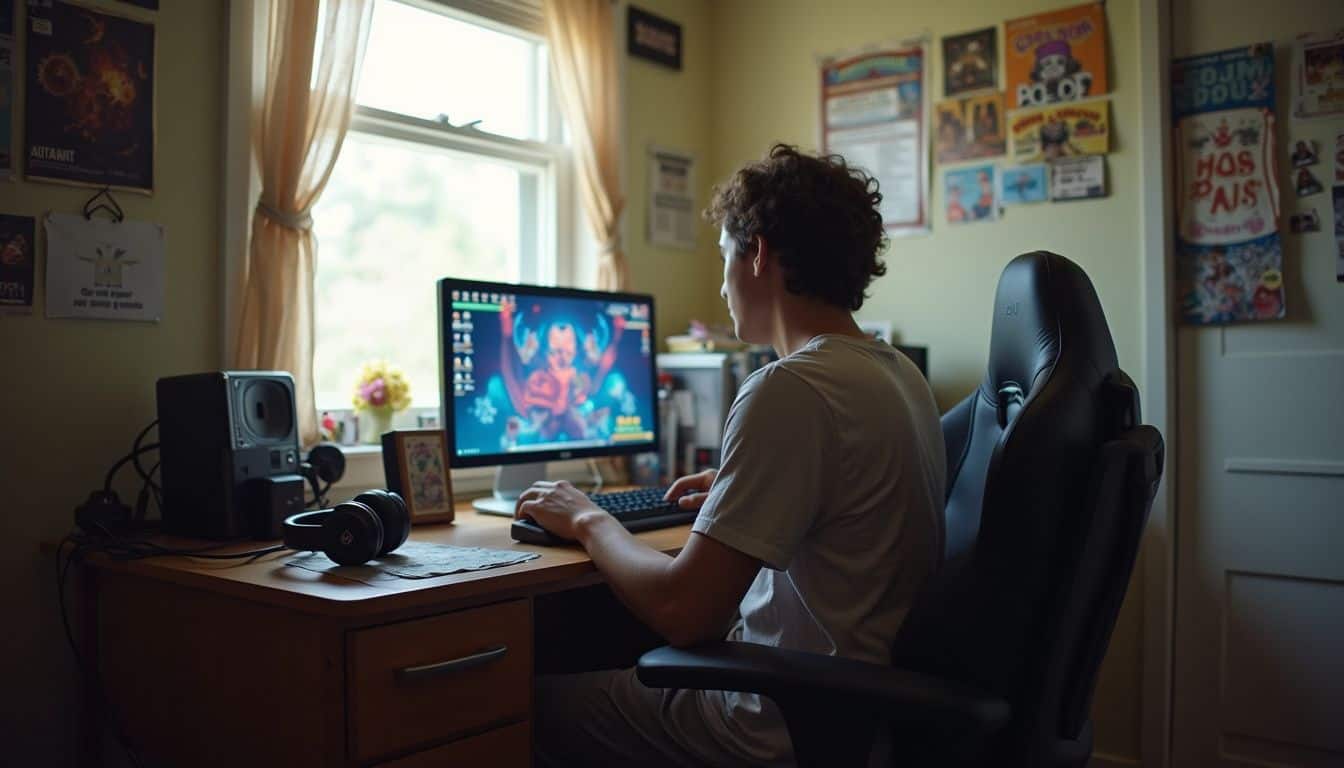
People often turn to games for escapism and immersion as a way to relieve stress or anxiety. During the COVID-19 pandemic, gaming engagement soared as players looked for a comfortable distraction.
Games like Animal Crossing: New Horizons became a digital sanctuary when the real world felt overwhelming. This kind of play provides a sense of control and achievement that might be missing from daily life.
Immersion allows you to step away from your routine and lose yourself in a fantasy world. When you’re in that “flow state,” your brain tunes out worries as you focus on leveling up or solving a puzzle. This can be a great way to build confidence and connect with friends in communities on Discord or Twitch.
It’s all about balance. While escapism is a healthy outlet for many, studies show that if taken too far, it can sometimes be linked to increased anxiety or loneliness. It’s this interesting dynamic that keeps the conversation going.
Social and Cultural Factors Shaping Gamer Identity

Platforms like YouTube, Twitch, and Discord play a huge role in how gamers see themselves. They’re also where stereotypes can spread quickly through forums and social media.
How does gaming culture and media influence gamer identity?

Gaming culture is built on shared jokes, memes, and lingo that you’ll find all over Discord servers and Reddit threads. Media coverage elevates this gamer identity by putting esports stars and popular Twitch streamers in the spotlight.
For example, the 2024 League of Legends World Championship became the most-watched esports tournament in history, with a peak of over 6.9 million viewers (excluding China). When an event gets that big, it shapes how the world sees gaming.
Unfortunately, the most visible voices in gaming are often white and male, which can make it hard for people from other backgrounds to feel like “real” gamers. The language used in games, like sorting players into “core” or “casual,” can also create divides.
Thankfully, games with better female and LGBTQ+ representation are helping to break down these old barriers. You can find more examples of how these networks work in this explanation of gaming culture.
What stereotypes exist about gamers?

Gamers are often stereotyped as young, socially awkward males living in their parents’ basements. TV shows and movies have long portrayed them as slackers, like Comic Book Guy from “The Simpsons.”
This created the idea that only hardcore guys play games, while casual players, especially women, are often met with gatekeeping. Another common stereotype is that serious gamers are obsessed with competition and toxic trash talk. A 2022 report from the Anti-Defamation League (ADL) found that 86% of adult gamers aged 18-45 had experienced some form of harassment.
This toxic vibe can make people hesitate to join online games. I’ve seen friends avoid online sessions because they worry they won’t be seen as “real” players because of these gaming stereotypes.
I started calling myself a gamer after realizing everyone else expected me to fit one narrow mold, said Alex Chen, an esports commentator since 2016.
Things are slowly changing, thanks to greater LGBTQ representation in games like Dream Daddy: A Dad Dating Simulator. Still, these old ideas can stick around, affecting how people see themselves.
How has society’s view of gaming changed?
Many people used to see gaming as a lazy or even harmful hobby. Now, it’s gaining widespread respect as both a valid pastime and a professional career.
What caused the shift? Technology made games more accessible, and celebrity gamers on YouTube and Twitch made it cool. It also helps when mainstream stars like Henry Cavill and Snoop Dogg openly share their love for games like World of Warcraft and Call of Duty.
Old stereotypes are fading. Female players make up a huge part of the community, and the LGBTQ+ community, including gaymers and transgender players, is more visible than ever. The global gaming market is now bigger than the film and music industries combined, proving it’s a major cultural force.
Esports and professional competitions have put skilled players on the map. Society now often sees gaming as a way to learn teamwork, build friendships, and even forge a career. The stigma has shrunk, while respect and awareness have grown.
Different Types of Gamers
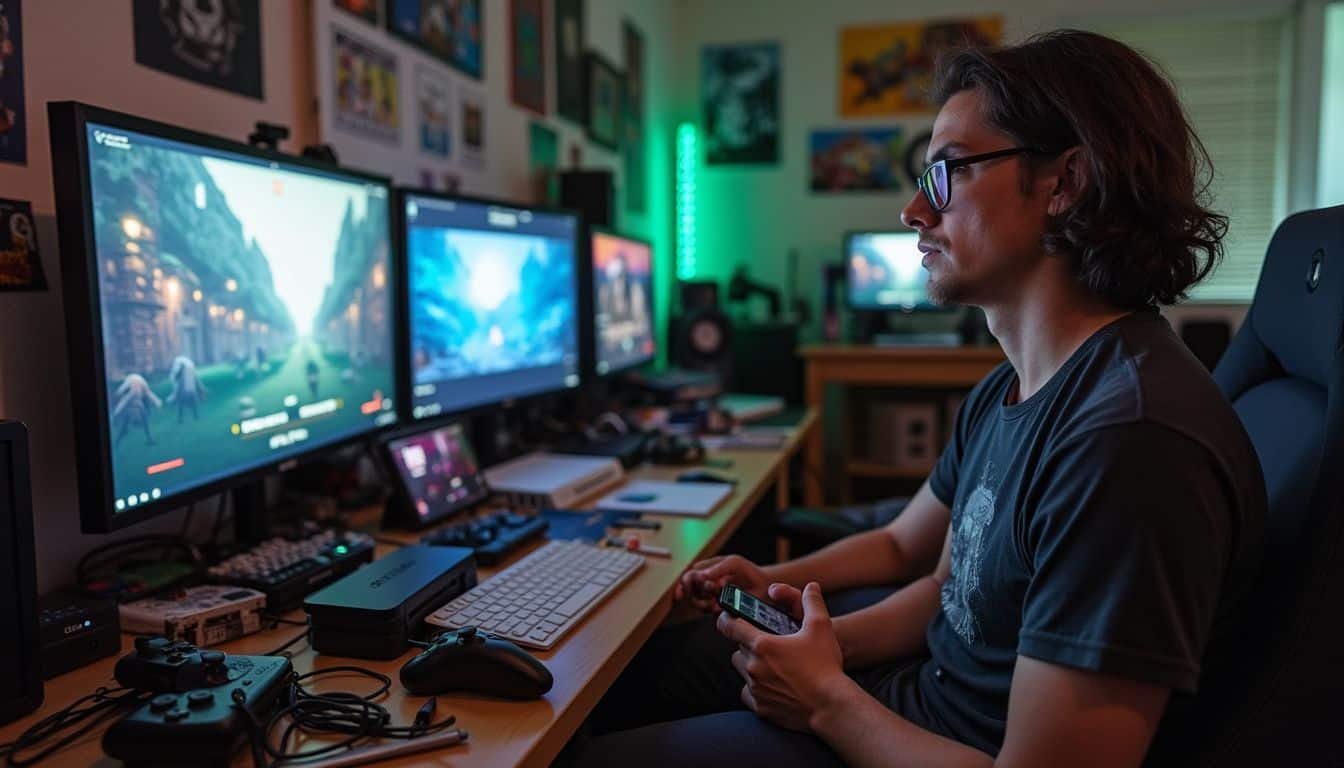
From fast-paced competitors to chill retro fans, there’s a gamer group for everyone. Read on to find your tribe.
Who are casual gamers?
People who play games like Candy Crush or Animal Crossing on their phones, tablets, or web browsers are typically considered casual gamers. They usually play for a few minutes at a time and prefer simple controls and fun themes.
In 2024, the top-grossing casual mobile game was Monopoly Go!, which earned a staggering $1.5 billion. This shows just how massive the casual gaming audience is. Many of these players enjoy gaming for up to 20 hours a week but might not even think of themselves as “gamers.”
Most casual gamers are looking for quick fun rather than deep, complex challenges. I have several friends who love relaxing with puzzle apps after work but wouldn’t touch a competitive shooter. For them, gaming is about comfort and stress relief.
What defines hardcore gamers?
Hardcore gamers are the folks who pour hours into mastering complex game mechanics and chasing victory. They’re often found grinding through intense shooters like Counter-Strike: Global Offensive or leading raids in MMOs.
You’ll recognize their setups: high-powered gaming PCs, mechanical keyboards, and professional headsets. They live by tournament schedules and treat gaming as a lifestyle. They love competition, dive into online forums for debates, and hunt for every last achievement in a game.
The Bartle taxonomy of player types often calls these players “Achievers” and “Killers.” They’re driven by challenge and dominance.
I don’t just play; I train.
You can dig deeper into the differences here: hardcore vs casual gamers.
What is the role of professional gamers?
Professional gamers are the elite athletes of the gaming world, competing in esports tournaments for huge prizes and career recognition. Esports became a medal event at the 2022 Asian Games, putting pros on a truly global stage.
The money is serious. As early as 2006, Major League Gaming was offering contracts worth $250,000 a year. Some top players earn over $100,000 annually just from competing. The esports industry is projected to hit $4.8 billion in revenue by 2025, showing just how big the business has become.
Training is intense, often involving strict practice schedules, strategy sessions, and reviewing replays with tools like OBS Studio. Many young people now see pro gaming as a legitimate career path, with universities like the University of California, Irvine offering esports scholarships and programs.
Who are retrogamers?
While pro players are battling for future glory, retrogamers are all about celebrating the classics of the past. They’re the ones playing Sonic on an original Sega Genesis or reliving Mario battles using emulators like DuckStation.
Some build massive game collections, hunting down original hardware to get that authentic pixelated experience. It’s like being a time-traveling geek who wants to keep gaming history alive.
On forums like Reddit’s r/retrogaming, you’ll find fans debating which titles are true collectibles, like Street Fighter II or The Legend of Zelda: A Link to the Past. By sharing stories and preserving old hardware, retrogamers help protect the cultural heritage that influenced all the games we love today.
What are gaymers and other niche gaming communities?
Gaymers, a term for LGBTQ+ players, have built amazing communities where people can connect over games and express their identities freely. According to GLAAD, nearly 20% of American gamers identify as LGBTQ+.
These communities provide safe havens from the harassment that many queer players face online. Games with positive representation, like Thirsty Suitors, which won an authentic representation award in 2024, are celebrated for making the gaming world more inclusive.
While economic gaps still exist for queer professional players, niche groups are thriving. Organizations like GaymerX host conventions that create supportive spaces, and women-only guilds or collectives for disabled gamers are helping members find community beyond the typical online scene.
Who Are Gamers? Demographic Insights
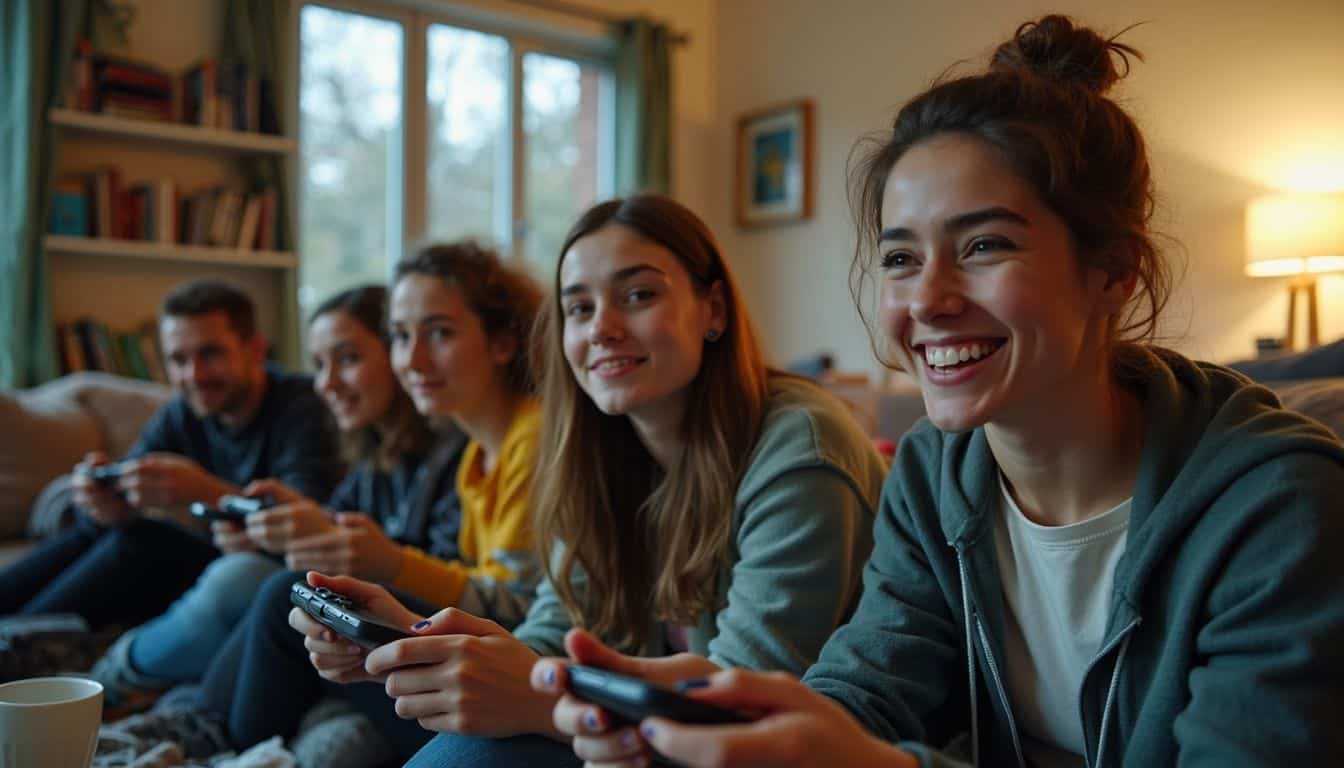
Gamers come from every age group, gender, and corner of the world. Let’s look at the numbers and see how you fit in.
What ages are most common among gamers?
People of all ages are picking up controllers. The average U.S. gamer is 36 years old, according to the ESA’s 2024 report. That old stereotype of a teenager in the basement is officially outdated.
Here’s a quick breakdown of who’s playing in the U.S.:
- Adults (18+): The vast majority of players are adults. The 18-34 age group is the largest, making up about 38% of all gamers.
- Older Adults (50+): Gaming is increasingly popular with older generations. Today, 29% of players are 50 or older.
- Kids and Teens: Of course, younger generations are still huge fans. About 20% of players are under 18.
I see this in my own life, I’ve grown up with Atari joysticks and now I’m mastering a PlayStation controller. Every generation has found its place in the gaming world.
How diverse is the gaming community in terms of gender?
Female gamers are a huge and growing part of the community. In the U.S., the gender split is nearly even, with about 46% of players identifying as female.
Despite making up almost half the audience, women are often less likely to call themselves “gamers.” One Pew Research study found that only 6% of American women publicly use the label, compared to 15% of men. This is often due to the stereotypes and gatekeeping that still exist in some corners of gaming culture.
Interestingly, girls tend to start playing a bit later than boys (around age eleven, compared to eight for boys). However, once they start, they are just as dedicated. Many female PC players identify as core or hardcore fans, proving that skill and passion have nothing to do with gender.
Where are gamers located geographically?
Gamers are everywhere. The global gaming population is massive and spread across every continent. Projections show there will be over 3.5 billion gamers worldwide in 2025.
The Asia-Pacific region is the epicenter, with an incredible 1.48 billion players. This region alone accounts for nearly half of the world’s gaming revenue. Europe follows with about 715 million players, and North America has around 285 million.
| Region | Number of Gamers (2024) |
|---|---|
| Asia-Pacific | 1.48 billion |
| Europe | 715 million |
| Latin America | 420 million |
| North America | 285 million |
Emerging markets in Latin America, Africa, and the Middle East are also growing rapidly, thanks to the spread of mobile gaming and cloud services like Xbox Cloud Gaming.
How Games Influence Personal Identity
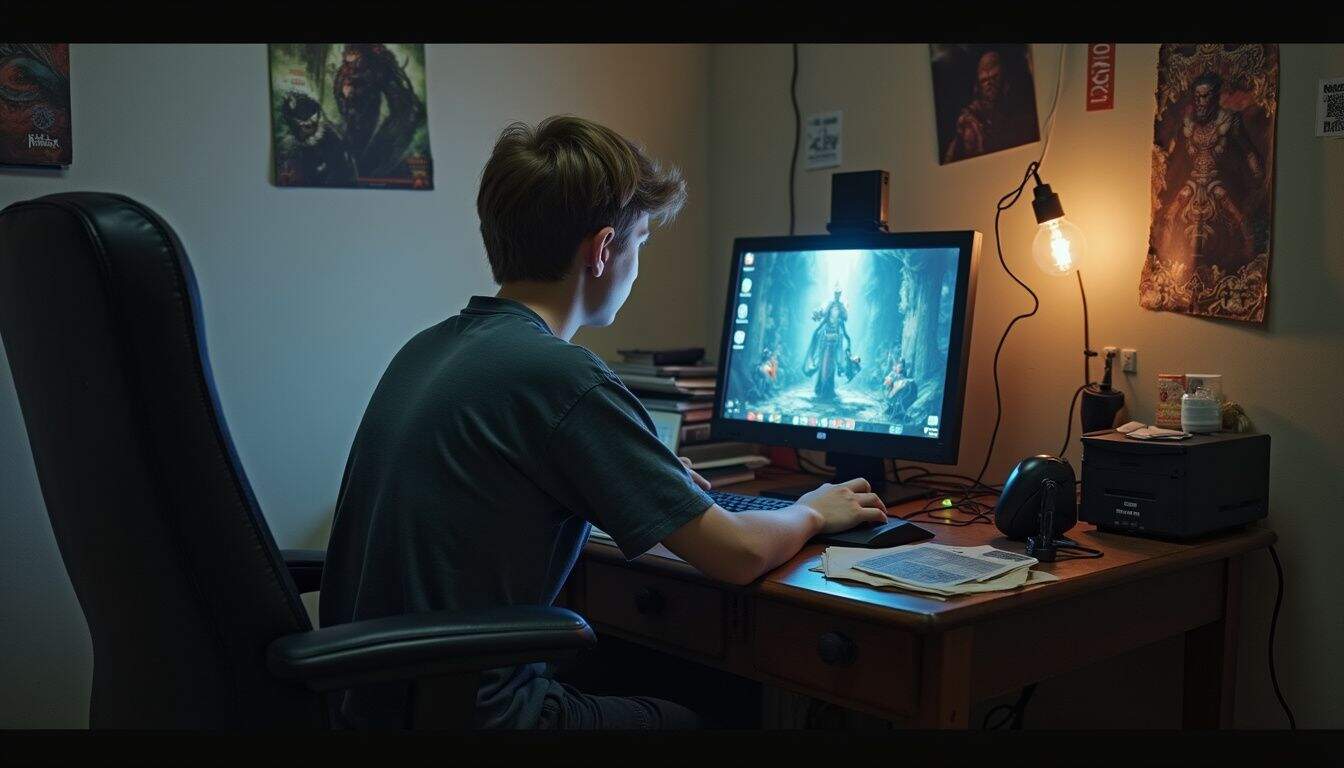
Games give us a chance to play around with digital personas using avatars and custom profiles. Role-playing games in particular offer a safe space to explore who we are.
How do avatars and characters personalize gaming?
Players build their digital identities by creating avatars that reflect who they are, or who they want to be. Games with deep customization options, like The Sims or Baldur’s Gate 3, let you fine-tune everything from hairstyles to personality traits.
These choices help forge a deep emotional bond with our in-game characters. Your gamer tag, like “Ninja,” or your clan’s colors also signal your connection to a wider community.
Customization goes beyond just looks. You can design an avatar that’s a direct reflection of your real self or experiment with an idealized version, one that’s braver or more outgoing. The more powerful the customization tools, the stronger that attachment becomes.
How does role-playing support self-expression?
Role-playing games (RPGs), from tabletop classics like Dungeons & Dragons to sprawling video games, are fantastic for self-expression. They provide a safe space to try on different identities and explore traits you might not show in your everyday life.
Through your character, you can be loud, brave, or quirky. It’s a creative outlet that can even boost your confidence, as friends in your party support your choices.
For many players in niche communities, RPGs offer a place of genuine acceptance. It’s a space where people can express their true selves without fear of judgment. The shared creativity builds friendships and reinforces personal identity for everyone at the table.
In what ways do game genres impact gamer identity?
The genres you love also shape how you see yourself as a player. Each one offers a different experience and attracts a different kind of community.
Action games like Call of Duty can make you feel sharp and competitive by honing your reflexes. RPG fans often dive deep into character drama and complex stories. The massive success of Baldur’s Gate 3, which won Game of the Year at the 2024 Gayming Awards, shows how much players value deep, narrative-driven experiences.
Cooperative games like Animal Crossing help build tight-knit communities and a strong sense of belonging. Competitive esports titles like League of Legends create intense pride and brand awareness around teams and players. Your favorite genre can say a lot about what you value in your gaming life.
Why Do Some People Avoid the “Gamer” Label?

Some people play games like League of Legends or Minecraft for hours but still wouldn’t call themselves a gamer. That word can carry some heavy baggage, thanks to old stereotypes and online toxicity.
What does casualization of gaming mean for identity?
The rise of casual gaming has completely changed the conversation about who gets to be a gamer. Games like Candy Crush and Among Us opened the door for everyone to play, not just people grinding through difficult games.
Because of this, many frequent players now avoid the “gamer” label. It can feel like an exclusive club reserved for the hardcore crowd. I see it all the time, my aunt is a master at mobile puzzle games but would never call herself a gamer.
This shift means that game companies have to rethink how they market their games. The casual audience is huge, but they often ignore ads aimed at traditional “gamers.” The rise of casual play has made gaming mainstream, but it has also sparked debates about what “real” gaming is.
What negative associations are linked to the term “gamer”?
The word “gamer” can sometimes come with unwanted baggage. Old media portrayals often painted gamers as isolated, unproductive teenage boys locked in their rooms.
Stereotypes about being socially awkward or lacking ambition still linger. Some people have even joked that gamers make less desirable partners, which can sting if you’re proud of your hobby.
These negative views can push women and LGBTQ+ players away from the label. In some online spaces, “gamer” is used as a tool for gatekeeping, creating exclusion instead of connection.
I have seen friends shy away from the identity just to avoid the stigma. This outdated view still impacts how people see themselves, even as the wider community becomes more diverse and open every year.
Why do some players not strongly identify with gamers?
Those negative stereotypes are a big reason why “gamer” can feel like a loaded term. A lot of mobile players, like my cousin who plays Monopoly Go! every day, just don’t connect with the label. She’s just having fun, not trying to be a joystick warrior.
Even though the vast majority of Americans play games, studies show only a fraction of them embrace the “gamer” badge. For many, it’s just a way to relax after work or kill time on their phone.
Some women and minorities also hesitate because of the toxic online spaces that can feel unwelcoming. For others, it’s simply a matter of commitment. They play when they have time but aren’t interested in the cliques or drama. There’s no single mold that fits every player.
Understanding Commitment Levels in Gaming
Some players log a few hours a week, while others build their entire schedules around raids and Discord chats. Let’s see where you might fit in.
How much time do different gamers invest?
Casual gamers often play in short bursts, sometimes clocking up to 20 hours a week without really thinking about it. On the other end of the spectrum, about a third of all surveyed players game for at least 3.5 hours every single day.
Hardcore fans plan their lives around game releases and tournaments. They might dedicate entire evenings or weekends to leveling up, managing online guilds, or climbing the esports ladder on platforms like Steam or Xbox Live.
While a small percentage of people (about 8%) game so intensely that it can affect their well-being, research has found no strong link between the total hours spent gaming and a person’s overall happiness. It’s all about how you play, not just how much.
What emotional connections do gamers have with games?
Players often form a strong bond with their avatars and the stories in games. Customizing a character or making choices in a narrative helps players see themselves in the game, leading to real emotional satisfaction.
Games like The Legend of Zelda can trigger powerful feelings of nostalgia. Replaying a classic can feel like visiting an old friend.
These emotional ties are what keep fans coming back for sequels and staying loyal to their favorite franchises. For some, gaming provides comfort during tough times and helps create connections that last long after the screen is turned off. This deep engagement is often what separates a hobbyist from someone who just plays casually.
How do hobbyists differ from gaming enthusiasts?
Hobbyists typically play games to relax and pass the time. In the U.S., about 27% of gamers are called “Time Fillers” because they’re just looking for something fun and easy, not a major challenge. They usually aren’t buying special gear or chasing high scores.
Gaming enthusiasts, on the other hand, dive much deeper into the community and culture. They’re the ones chasing achievements, competing in tournaments, and discussing strategies on Discord or Reddit. They often use pro-level gear from brands like Logitech or Razer.
These players care about earning respect within their gaming circles and strongly identify with the “gamer” label. For hobbyists, that label might not even cross their minds. It’s the motivation that makes all the difference.
What Defines Professional Gamers and Their Identity?
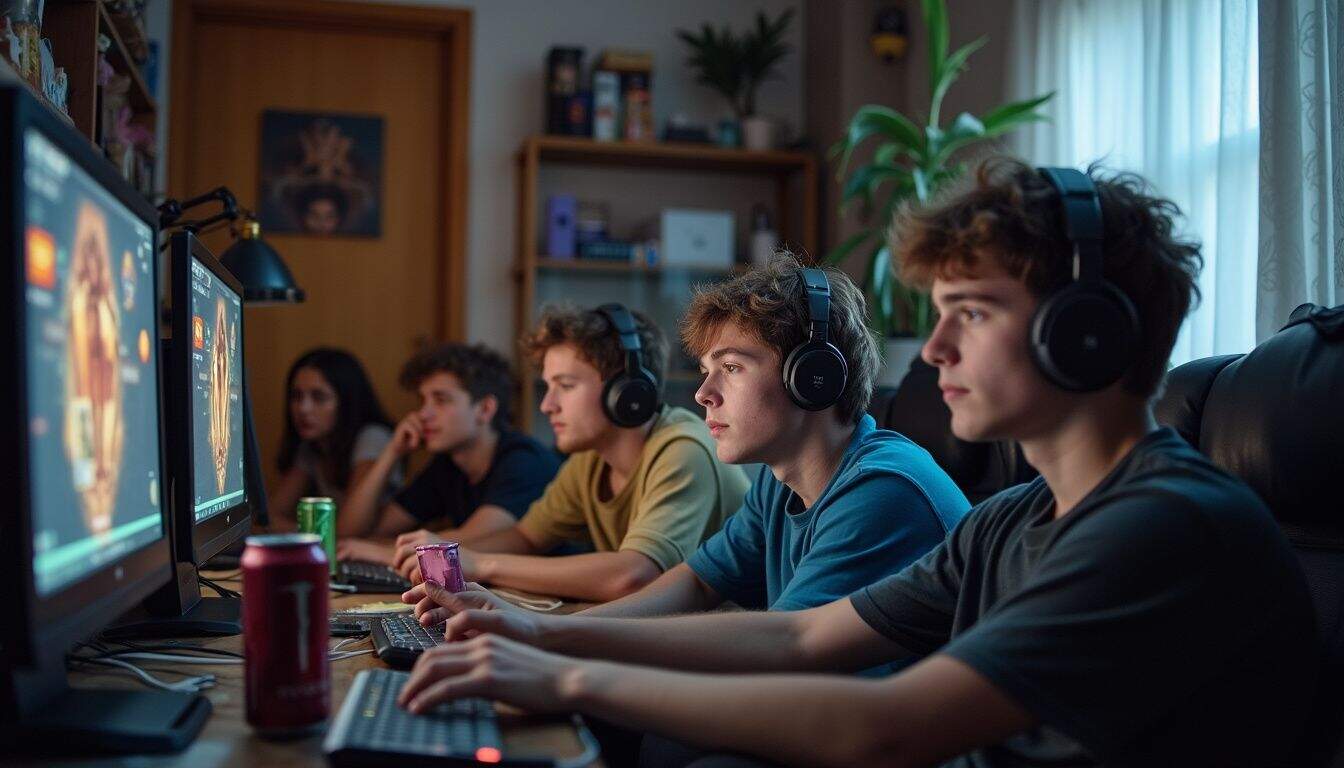
Pro gamers often approach esports with the same dedication as traditional athletes. Their image is shaped by Twitch streams and major tournaments, making them celebrities in their own right.
How has esports become a career path?
Esports has grown into a massive industry. It started gaining serious ground back in 2006 when Major League Gaming offered contracts worth $250,000. Today, players compete in structured leagues and tournaments all over the world.
The industry’s growth is explosive, with projections suggesting it could generate between $3 billion and $4.8 billion by 2025. I have friends who started as amateur players and now have jobs managing teams or planning events for companies like ESL Gaming.
Colleges are even offering esports management degrees, and esports was an official medal event at the 2022 Asian Games. The demand for skilled pros is higher than ever, turning a hobby into a viable and exciting career.
What is public opinion of professional gamers?
Many people still view professional gamers through a lens of outdated myths. They might picture someone playing in a basement or think it’s just a hobby for teenagers.
But the reality is very different. As of 2024, top players and streamers like Faker and Pokimane have become huge stars, earning millions from sponsorships and tournament wins. The 2024 League of Legends World Championship final, which T1 and Faker won, was a massive global event.
More people now respect gaming as a legitimate career, but some old ideas persist. Questions about gender and diversity in pro play still come up. While the rise of esports has challenged these old views, full public acceptance is still a work in progress.
What challenges do professional gamers face?
While public opinion is one thing, the real challenges for a professional gamer often happen behind the scenes. The stress is immense, especially during major esports events or campaigns for sponsors like Logitech and Twitch.
There’s also a constant pressure to perform. Tournaments in high-intensity games like Dota 2 or League of Legends are often male-dominated, which can affect team dynamics and create an unwelcome environment for others.
LGBTQ+ professionals have reported earning less on average than their straight peers. On top of that, pro gamers face the same mental pressures as traditional athletes, from grueling schedules and intense competition to the constant stream of internet trash talk.
Representation and Inclusivity in Gaming Communities

Developers are making a greater effort to add more diverse characters to their games. Brands like Discord and Twitch are also running campaigns to help all players feel welcome.
How are female gamers represented?
Women buy nearly half of all video games in the United States, yet they are far less likely to call themselves “gamers.” Among women aged 18 to 29, only 9% adopt the label, compared to 33% of men in the same age group.
The most visible streamers on Twitch and YouTube are still predominantly white and male, which reinforces old stereotypes. Women are often painted as casual players, and their skills can be overlooked in competitive scenes.
I stream on Discord with friends who avoid the “gamer” label, even though we play for hours every week. Many talented female players feel unwelcome because some gaming circles still feel like boys’ clubs. While the number of female players continues to rise, the culture is still playing catch-up on true inclusivity.
What is LGBTQ+ representation like in gaming?
Games are featuring more LGBTQ+ characters and storylines than ever before. Titles like The Last of Us Part 1 and Life is Strange have been praised for their nuanced queer themes and characters. RPGs with customizable characters also allow players to express a wide range of gender identities and romantic preferences.
Despite this progress, LGBTQ+ gamers still face challenges, including harassment and economic gaps. Events like the Gayming Awards are crucial for building safer spaces and celebrating inclusive games. The gaymers community continues to carve out an identity within gaming culture where everyone can feel welcome.
What efforts promote diversity and inclusion in gaming?
Studios are making a conscious effort to promote diversity by hiring more diverse staff and featuring characters from different backgrounds. Major companies like Xbox, Sony, and Nintendo support LGBTQ+ gamers through events like Pride Month promotions.
I once saw an indie developer update their game’s voice chat to make it safer for women and younger players. Groups like AbleGamers work to create more accessible options for people with disabilities.
Online communities are adding clearer rules against hate speech and harassment. Game designers are also gathering feedback from a wider range of players before launching new updates. My friends even joined a panel at PAX to discuss safe spaces in multiplayer games, and their ideas helped shape new chat filters the next year. These efforts are slowly but surely making gaming a better place for everyone.
How Is the Gamer Identity Evolving?
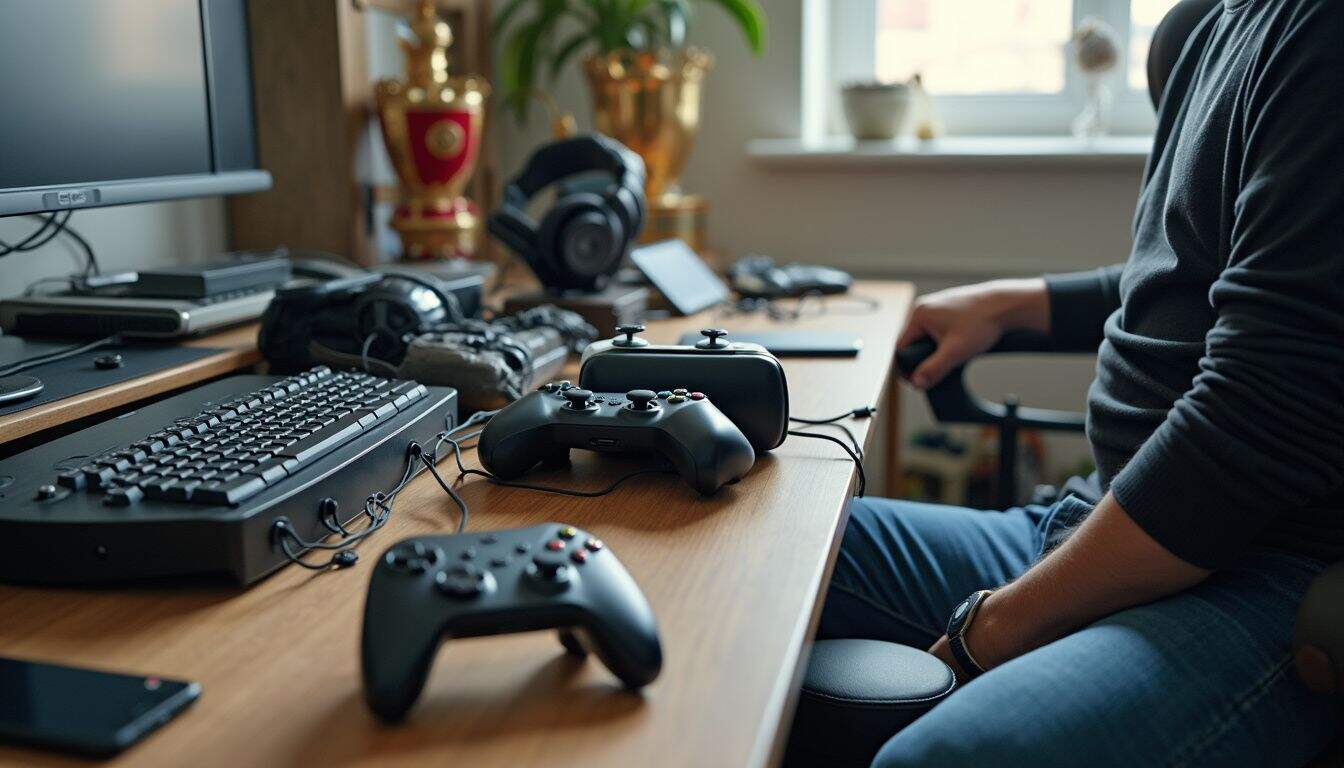
Mobile games, esports, and VR are all shaking things up. Let’s look at how these shifts are changing what it means to be a gamer.
What impact does mobile and casual gaming have?
Mobile and casual games have thrown the doors to gaming wide open. Smartphones have become powerful game consoles that fit in our pockets, bringing in huge new audiences.
I saw my neighbor’s grandma crushing levels on her phone while waiting for an appointment. She never would have called herself a “gamer” before, but now she’s part of a gaming community.
These experiences are changing what people picture when they hear the word “gamer.” Short play sessions and easy controls attract people who never thought they’d play video games. During the COVID-19 pandemic, millions used their phones to feel closer to friends through shared games.
Being a gamer no longer requires a powerful PC or console. It can simply mean playing a few rounds of a fun game while you’re waiting for the bus.
How do cross-platform gamers influence the community?
Mobile gaming brought in a bigger audience, and cross-platform play is connecting them all. Players on PlayStation, Xbox, Nintendo Switch, and PC can now all play together.
Games like Fortnite are a great example of this. Friends can team up no matter what device they’re using. This has helped break down the old console-war stereotypes and build a more unified community.
Cross-platform fans are opening up new ways for all kinds of gamers, from casuals to diehards, to connect. As someone who plays on both console and PC, I’ve noticed a lot more teamwork since crossplay became common around 2018. People care less about what you play on, as long as everyone is having fun.
How do new technologies shape gamer identities?
Technology is constantly rewriting what it means to be a gamer. Smartphones put full-fledged games in our pockets, bringing in millions of new players. The number of mobile gamers is projected to reach over 3.2 billion globally.
During the 2020 lockdowns, online gaming became a primary way to socialize. Games also started adding “Easy Mode” options, making them more accessible to casual players who just wanted to experience the story.
Thanks to fast Wi-Fi and cloud gaming, anyone can become a gamer on their lunch break. My friend’s mom beat me at Candy Crush last week, so it’s safe to say the meaning of “gamer” feels a lot different than it did five years ago.
How Will the Gamer Identity Change in 2025?
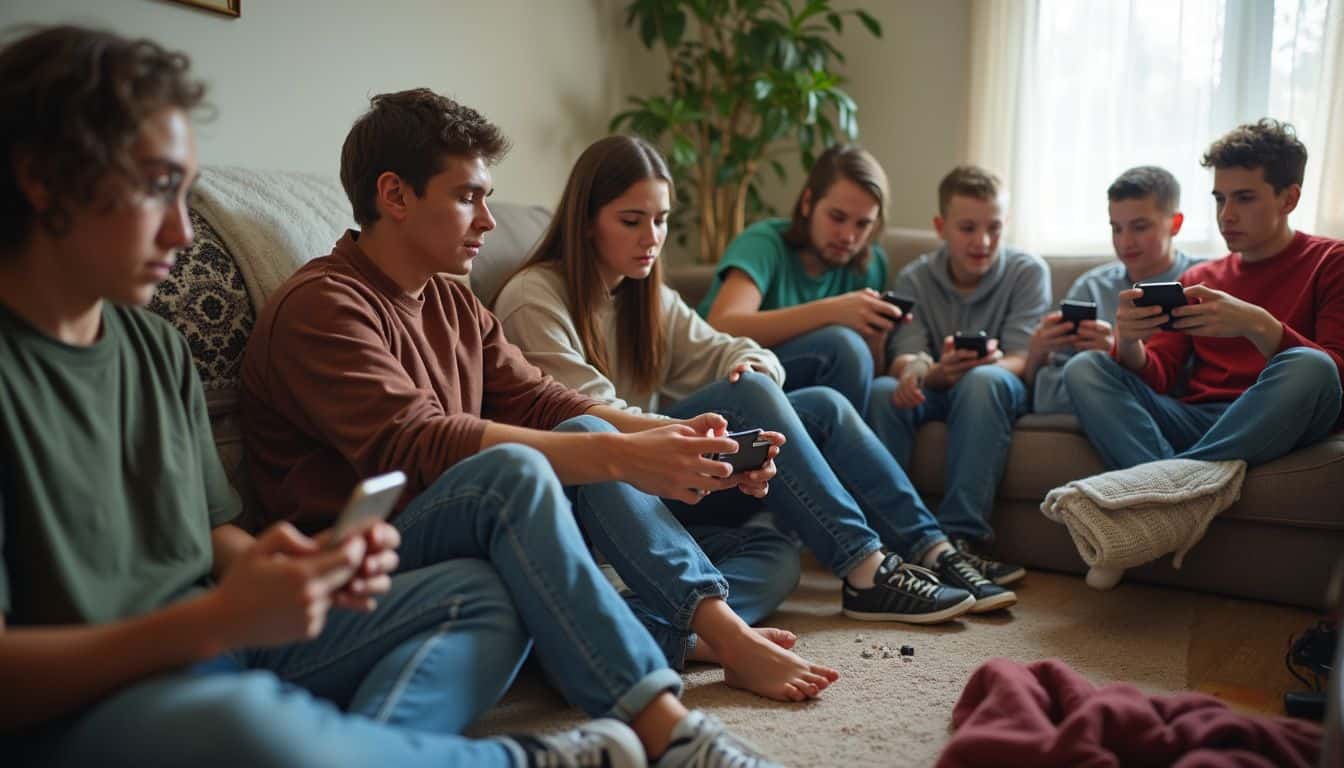
The gamer identity is set for another big upgrade in 2025. The line between casual and hardcore players is continuing to fade, thanks to powerful smart devices and easier access to games.
More women are joining the scene, broadening the idea of who counts as a “gamer.” Mobile games are bringing in new players every day, and many of them are skipping labels altogether because the old stereotypes just don’t fit.
Big companies like Microsoft and Sony are pushing cross-platform titles, which will only shrink the divides between communities. Esports now offers a real career path for talented players, with leagues for games like Fortnite and Rocket League gaining bigger audiences every year.
If you’d asked me five years ago whether my grandma would be streaming on Twitch, I would have laughed. Yet here we are. The definition of “gamer” is becoming more inclusive, blurring the lines across generations, cultures, and platforms.
People Also Ask
Why do people call themselves gamers instead of just saying they play games?
Calling yourself a “gamer” is a social shortcut that instantly signals you’re part of a massive global community with its own culture, much like being a fan of a specific sport.
How does calling yourself a gamer affect your social life?
It acts as an immediate friend-finder, helping you connect with people who share your passion in online spaces like Discord servers or by joining a specific clan in games like Destiny 2. This is especially true since a 2023 study by the Entertainment Software Association found that two-thirds of Americans play video games, making it a huge social connector.
Is there any link between being called a gamer and marketing?
Yes, the global games market is worth hundreds of billions, so companies build their brand awareness by targeting this label with specialized gear from brands like Razer or SteelSeries. This audience is highly engaged, making them a prime demographic for targeted campaigns.
Can calling yourself a gamer change how others see you?
It can definitely shape how people see you, turning a hobby into a shared identity that can lead to anything from a new group of friends to a professional career in the booming esports industry. The perception has shifted from a niche pastime to a recognized community with dedicated skills.
References
https://pmc.ncbi.nlm.nih.gov/articles/PMC10515229/
https://www.sciencedirect.com/science/article/pii/S0747563223002029
https://tryevidence.com/blog/gamer-motivation-theory/ (2025-01-14)
https://pmc.ncbi.nlm.nih.gov/articles/PMC10663235/
https://ijoc.org/index.php/ijoc/article/viewFile/19626/3976
https://show.gg/how-society-views-gaming/
https://300mind.studio/blog/types-of-gamers/ (2025-05-28)
https://pmc.ncbi.nlm.nih.gov/articles/PMC7438909/
https://gamescriticism.org/2023/07/19/public-memory-and-gamer-identity-retrogaming-as-nostalgia/
https://soar.wichita.edu/bitstreams/4a5d87c8-72e6-4151-8a15-bbcc4345288e/download
https://www.theesa.com/annual-esa-study-reveals-video-games-universal-appeal-across-generations/
https://pmc.ncbi.nlm.nih.gov/articles/PMC11577638/
https://www.sciencedirect.com/science/article/pii/S0747563223000456
https://cornerstone.lib.mnsu.edu/cgi/viewcontent.cgi?article=1161&context=ctamj
https://pmc.ncbi.nlm.nih.gov/articles/PMC11504367/
https://actaludologica.com/wp-content/uploads/2023/12/AL_2023-6-2_Study-2_Dietkow.pdf
https://pmc.ncbi.nlm.nih.gov/articles/PMC9719061/
https://www.sciencedirect.com/science/article/pii/S000169182500945X
https://www.baker.edu/about/get-to-know-us/blog/exploring-esports-industry-opportunities-in-competitive-gaming/ (2024-06-18)
https://www.pewresearch.org/internet/2015/12/15/gaming-and-gamers/ (2015-12-15)
https://academic.oup.com/jcmc/article/20/3/346/4067598
https://link.springer.com/article/10.1007/s43545-024-00980-z
https://pmc.ncbi.nlm.nih.gov/articles/PMC8835226/
https://www.npr.org/2024/02/29/1234590117/a-growing-number-of-gamers-are-lgbtq-so-why-is-representation-still-lacking (2024-02-29)
https://assets.glaad.org/m/5ab9a335d607edcd/original/2024-GLAAD-Gaming-Report.pdf
https://www.brunoschirch.com/blog/diversity-and-inclusion-in-the-gaming-industry (2024-06-25)
https://unity.com/fr/blog/niche-to-norm-evolution-gamer-identity (2025-04-16)
https://unity.com/blog/niche-to-norm-evolution-gamer-identity (2025-04-16)
https://www.emarketer.com/content/us-gamers-by-generation-2025 (2025-02-10)
